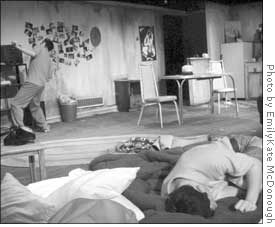
| << Front page | Arts | April 22, 2005 |
A LARGE CRITIC
 |
||
| Is this our youth?: Drugs make you tired. | ||
Perhaps the most impressive thing about last weekend’s production of This is our Youth was how bad the drugs were. It is usually hard to find someone willing to accept scratch in favor of quality stuff but the audience was more than willing. When seniors Raphael Sznajder and Dan Cox light up a zig-zag full of oregano, which they don’t even light because of Little Theater fire codes, my mother, from 50 feet away and without binoculars, could have seen they weren’t smoking pot. Yet, when Sznajder goes rambling on about brunch and how is it neither breakfast or lunch (perhaps the longest running debate about which no one actually cares), we all believed he’s stoned out of his face, even if he’s only been taking rips of Mrs. Dash.
The cocaine was also clearly flour. If you were sitting in the proper place, you could even feel the flour waft up and tickle your cheeks after Cox dumps the coke onto a plate to mix in the cut. Again, we all knew it was flour. Despite this, the majority of the audience, myself included, gasped and screamed when Cox, startled by the ring of the telephone, accidentally knocks $1,000 worth of “cocaine” on the floor. Sure, it was fake, but it was also that real.
Speaking of the telephone, the tech crew for this production deserves serious credit. Junior Farrah Joyner’s set immediately plunged us into the luxurious squalor of these characters with a set closed in enough to make us feel voyeuristic but open enough to keep us from feeling creepy about it. The sound design of sophomore Spencer Russell was also dead on, including just enough ambient noise to further draw us in, only to surprise us with a burst of Zappa. The most difficult and well-executed role was filled by an unknown properties manager. While the opening day Cubs hat was clearly a contemporary piece (the cubs didn’t introduce red into their caps until 1934), the rest of the collection was impressively accurate. In addition to an actual Major Matt Mason figurine, the Mothers of Invention album got me just as excited as Cox.
But this play was more than properties and fake drugs. It included three of the most inspired performances I have ever seen at Oberlin. Sznajder’s portrayal of Dennis, a loudmouthed drug dealer, was spot on. He filled Dennis with just enough bravado to force us to look past the puffed chest and see the young man who was petrified of being inadequate. Senior Whitney Laucks’s performance as Jessica mixed vulnerability with caginess, like an animal that has one leg in a trap but is proud that the other three remain free.
Finally, the strongest performance of the evening, if one can even say such a thing, came from Cox. As Warren, a frightened bumbler, Cox has to tackle the biggest challenge in the show — being on stage alone. His telephone conversation with his father, which ends “I hate you too!” is possibly the most heart-wrenching moment in the show. From the first time his voice crackles through the intercom to his slump-shouldered agreements in the final moments of the play, Cox nervous-ticks his way into and out of the most tense moments of the piece with top-notch skill.
Sure, some of the jokes were dated and the lighting was a little overly
dramatic and the drugs were fake, but who cares? With the exception of last
spring’s for colored girls..., which does not sit superior but as a
peer to This is Our Youth, I have never seen a better production at
Oberlin College.
About us
Subscriptions
Advertising